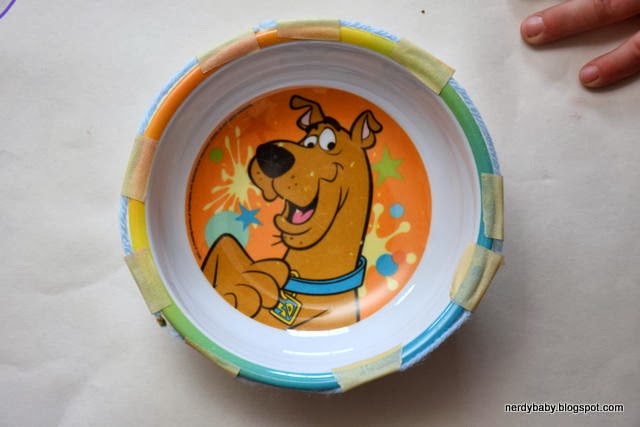While making our Pi Day Posters, we decided it would be a good time to investigate Pi: the ratio of the circumference of the circle to its diameter.
Then we measured the diameter of the circle, three different times, using yarn. What is the diameter of a circle? It's a line that cuts the circle in half, which you can do many (well, infinite) ways. We chose to be satisfied with measuring the diameter three ways. We cut the length of the diameter out of string/yarn:
We compared the length of the strings to see if the diameters were the same:
The diameters are about the same length (we live in an imperfect world and yarn is stretchy and was probably cut at different tensions - and the circle was traced by a four year old).
We then thought it would be easiest to tape the yarn to the outside of the bowl that was traced, along its circumference. We asked J if one piece of yarn, that we had cut to the length of the diameter, would fit all the way around the bowl. His hypothesis: "No!"
He was correct (the string is hard to see in the picture, so we marked the beginning and end with markers, the string is going from purple to red):
Then we asked about 2 pieces of yarn we had cut to the length of the diameter. He wasn't as certain, but he answered "No," again. He was correct, again (the string is going from red to purple, sorry for the inconsistency):
It took all three strings to make it around the bowl (the yarn we used was pretty stretchy and the actual circumference of the bowl was a tad bit smaller than what we had traced).
So how many strings, measured to the length of the circle's diameter, did it take to go around the bowl? About 3! This is approximating Pi! The actual ratio of circumference to diameter length is an irrational number that goes on forever and ever. It starts out 3.14159 and keeps going. For our 4 year old, seeing that Pi is about 3 made this activity a success!
This ratio, Pi, is used to calculate many things like angles and circular motion, but it takes a lot of math to get into that fun stuff. The most common uses of Pi are found in geometry, like finding the: circumference of a circle = Pi*diameter; area of a circle = Pi*(diameter/2)^2, and the volume of a sphere = 4/3*Pi*(diameter/2)^3.
We traced a circular bowl on the paper:
Then we measured the diameter of the circle, three different times, using yarn. What is the diameter of a circle? It's a line that cuts the circle in half, which you can do many (well, infinite) ways. We chose to be satisfied with measuring the diameter three ways. We cut the length of the diameter out of string/yarn:
The diameters are about the same length (we live in an imperfect world and yarn is stretchy and was probably cut at different tensions - and the circle was traced by a four year old).
We then thought it would be easiest to tape the yarn to the outside of the bowl that was traced, along its circumference. We asked J if one piece of yarn, that we had cut to the length of the diameter, would fit all the way around the bowl. His hypothesis: "No!"
He was correct (the string is hard to see in the picture, so we marked the beginning and end with markers, the string is going from purple to red):
Then we asked about 2 pieces of yarn we had cut to the length of the diameter. He wasn't as certain, but he answered "No," again. He was correct, again (the string is going from red to purple, sorry for the inconsistency):
It took all three strings to make it around the bowl (the yarn we used was pretty stretchy and the actual circumference of the bowl was a tad bit smaller than what we had traced).
So how many strings, measured to the length of the circle's diameter, did it take to go around the bowl? About 3! This is approximating Pi! The actual ratio of circumference to diameter length is an irrational number that goes on forever and ever. It starts out 3.14159 and keeps going. For our 4 year old, seeing that Pi is about 3 made this activity a success!
This ratio, Pi, is used to calculate many things like angles and circular motion, but it takes a lot of math to get into that fun stuff. The most common uses of Pi are found in geometry, like finding the: circumference of a circle = Pi*diameter; area of a circle = Pi*(diameter/2)^2, and the volume of a sphere = 4/3*Pi*(diameter/2)^3.
As for our Pi treat and holiday photo, tune in tomorrow to see our creation and annual family Pi Day Photo.
Blog Hop Time! Check out what these fantastic educators are doing about Pi and Pi Day!
We Love Math blog hop is hosted by









This is very cool! Can't wait to try these activities out with my kids this afternoon!
ReplyDeleteI hope you have as much fun as we did!
DeleteThis is great!! What a fun hands-on way to teach Pi! :)
ReplyDeleteWhat a great idea for teaching a complicated subject to a preschooler! Thank you for sharing!
ReplyDeleteThanks for stopping by and the wonderful compliment. We're just beginning the introduction of the concept of pi.
DeleteI didn't even realize we did similar activities!! Lol. I'm coming back here for more ideas next year. ;-)
ReplyDeleteGreat minds think alike!
Delete